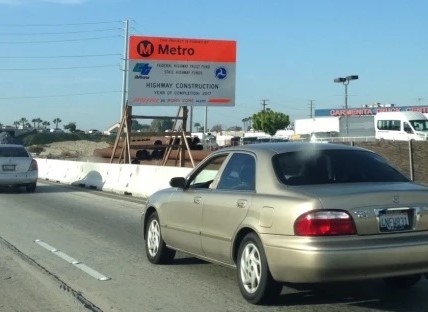Metro is spending more and more money widening freeways. Last year, Metro increased its annual freeway expansion budget by a whopping eighty percent. This year, the agency has proposed another 33.5 percent increase, on top of last year's. At a time when equity, housing, and climate crises are bearing down on Angelenos, Metro is planning to worsen these crises by doubling down on freeway widening - growing its annual Highway Program budget from $264 million (in FY21) to a proposed $634 million in the year ahead (FY23).
Some Angelenos think that Metro is just a transit agency, running buses and trains. This isn't true. Years ago, Metro leadership sought to raise funds by putting sales tax increases before L.A. County voters. To sweeten the pot for suburban driver voters, Metro included a great deal of dedicated freeway spending in Measures R and M. Around 35 percent of Measure R is dedicated to supporting driving. Measure M has about 33 percent.
To justify last year's eighty percent increase, Metro leadership downplayed overwhelming public input against freeway widening by lying about the highway program. At last year's highway budget hearing, Metro staff, board, and CEO made numerous false claims, including:
- “We’re not approving freeway expansions… it’s freeway modernization”
- "It’s not highway widening, it is hot spot improvements and modifications.”
- “Finishing the gaps on the 57, on the 71, [is] not really widening of the freeway.”
- “[In Measure M, there are] not just the improvement projects – you’ve got some widening"
None of these are true. Read SBLA's full rebuttal post busting these pernicious myths.
Today's post is an attempt to get ahead of Metro's falsehoods regarding highway expansion. Below is Metro's proposed $634 million FY23 Highway Program budget detail.
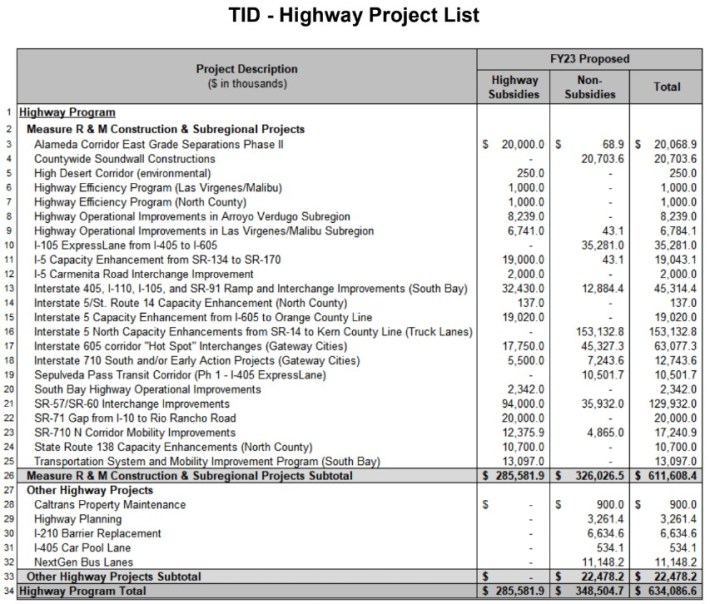
Following is a rundown of the freeway widening projects in the above Highway Program budget, in the order they appear.
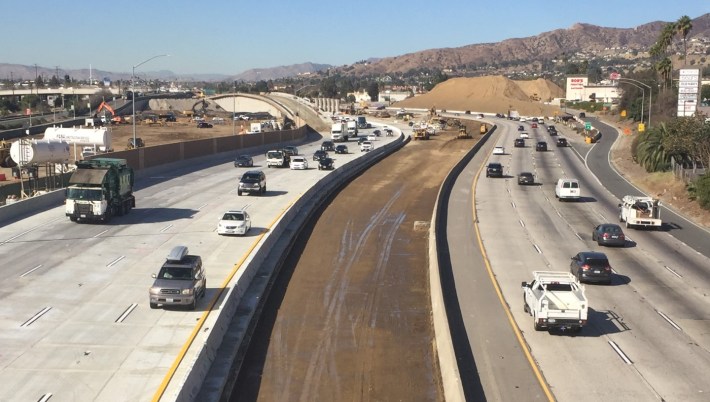
I-5 Capacity Enhancement from SR-134 to SR-170
Project cost: $1.3+ billion
FY23 proposed: $19.04 million
Widening: from 8 lanes to 10 lanes
Metro and Caltrans' under-construction Burbank area 5 Freeway widening is five years late. The project widens the freeway from 8 lanes to 10 lanes, adding new carpool lanes. The project overshot its budget, necessitating Metro loaning Caltrans $73 million to avoid pausing construction in 2021.
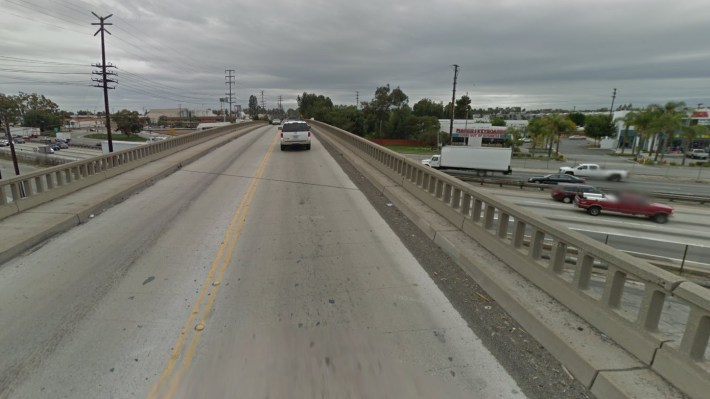
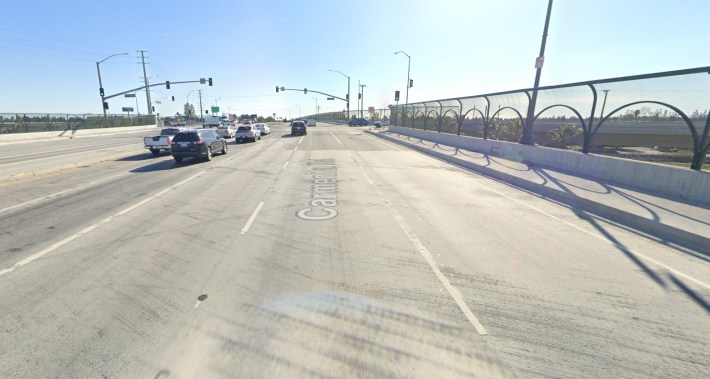
I-5 Carmenita Road Interchange Improvement
Project cost: $380 million (part of a $1.9 billion widening)
FY23 proposed: $2 million
Widening: 2 lanes to 10 lanes
Part of Metro and Caltrans' under-construction 5 Freeway widening from the 605 to Orange County (see below), the Carmenita Road bridge replacement demolished an existing two-lane bridge, replacing it with a ten-lane wide bridge, which Caltrans and Metro were proud to proclaim "a structure nearly five times its current size." The new bridge opened to traffic in late 2016; the continued budget allocation is perhaps due to continuing work on the associated freeway widening. (Widening a two-lane bridge here is termed an "interchange," perhaps to justify the hundreds of millions of dollars for this widening.)
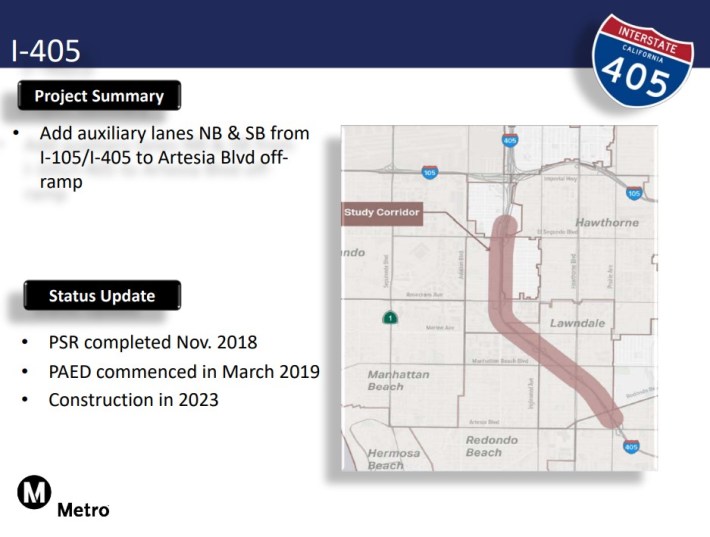
Interstate 405, I-110, I-105, and SR-91 Ramp and Interchange Improvements (South Bay)
Project cost: at least $250 million
FY23 proposed: $45.31 million
Widening: various, including 405 Freeway from 8 lanes to 10 lanes
This category (like the 605 "Hot Spots" below) is a sort of slush fund used for various freeway/ramp/street widening projects in the South Bay. Among these is a large-scale widening, due to start construction in 2023, of 3.5 miles of the 405 Freeway through Hawthorne, Lawndale, Redondo Beach, and Torrance. Metro's 405 widening project adds two new general purpose auxiliary lanes. ("Aux" lanes run from ramp to ramp. Sometimes highway builders like to claim that they are not really adding capacity, just adding auxiliary lanes - though more aux lanes mean more traffic, just like all other general purpose lanes.)

Interstate 5/St. Route 14 Capacity Enhancement (North County)
Project cost: unknown
FY23 proposed: $437 thousand
Widening: unknown
Given that this project does not appear on Metro's projects webpage, and the dollar amount is small, this appears to be Metro making plans for a new freeway capacity enhancement (ie: widening) project.
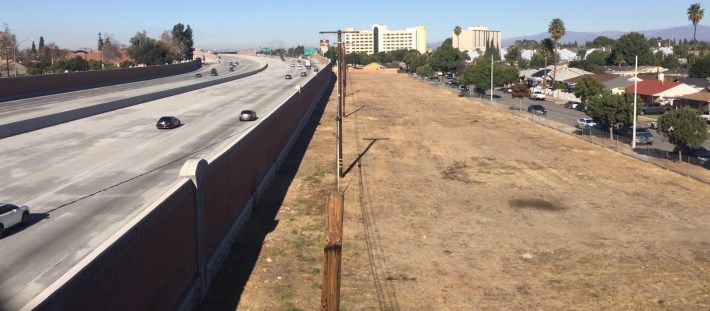
Interstate 5 Capacity Enhancement From I-605 to Orange County Line
Project cost: $1.9 billion
FY23 proposed: $19.02 million
Widening: from 8 lanes to 12 lanes
Metro and Caltrans are nearing completion of this seven-mile-long megaproject to add four more lanes (a new general purpose lane and new HOV lane in each direction.) The project already demolished hundreds of homes and apartments (423 parcels - most of them residential), completely erasing former freeway adjacent neighborhoods and businesses. Construction got under way in 2011, and is anticipated to conclude this year.
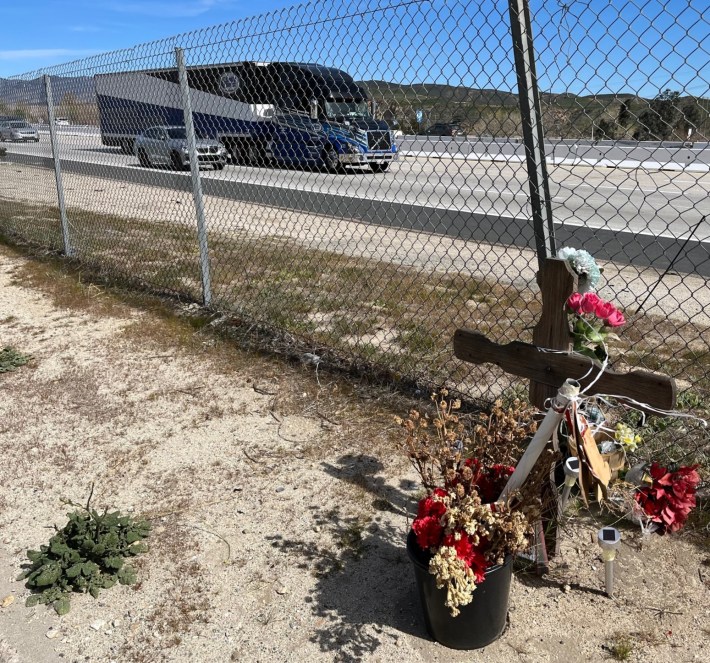
Interstate 5 North Capacity Enhancements from SR-14 to Kern County Line (Truck Lanes)
Project cost: $679 million
FY23 proposed: $153.13 million
Widening: from 8 lanes to 10-12 lanes (12 lanes for the widest stretch, about three miles)
Metro broke ground on their North County 5 Freeway widening in late 2021. The project adds new carpool lanes (for the full 13.5 mile length), and new truck lanes and general-purpose auxiliary lanes for shorter stretches.
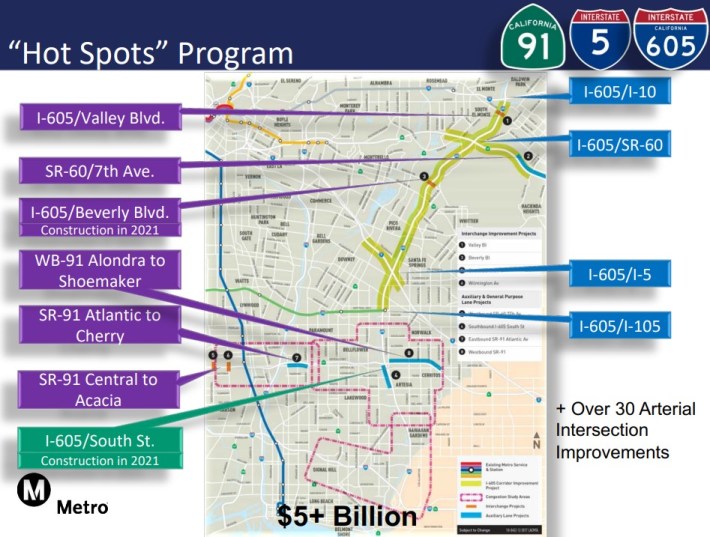
Interstate 605 corridor "Hot Spot" Interchanges (Gateway Cities)
Project cost: $5+ billion (sometimes the 605 Freeway Corridor Improvement Project is included, and then it's $10+ billion - see August 2020 example slide)
FY23 proposed: $63.08 million
Widening: varies - includes multiple 91 Freeway widening from 8 lanes to 10-11 lanes
Metro's vaguely defined 605 corridor hot spot projects are various widenings of freeways, surface streets/intersections, on/off-ramps near the 605, 710, and 60 Freeways. (The definition of "hot spots" seems to be that if it's a widening requested in the Gateway or San Gabriel Valley sub-regions, then it can be justified for "605 corridor" funds.) Three freeway widenings called 605 Hot Spot projects are widening the 91 Freeway, adding general purpose and auxiliary lanes. Most of these hot spot projects are smaller (which means 'tens of millions' here), including adding more lanes to onramps and streets that lead to the 605.
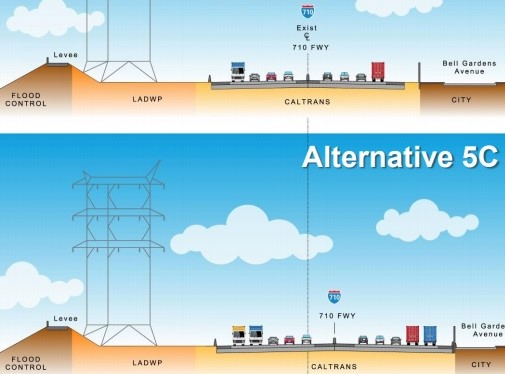
Interstate 710 South and/or Early Action Projects (Gateway Cities)
Project cost: was $6+ billion, now unclear
FY23 proposed: $12.74 million
Widening: from 8 to 16 lanes proposed, then 8 to 10 lanes approved, then suspended
In 2018, Metro approved a plan to widen the lower 710 Freeway by adding two new general purpose lanes. When the federal Environmental Protection Agency and Caltrans nixed the project, Metro paused it, instead now studying a "multimodal investment strategy." A portion of the funding would go to Early Action Projects (EAP) that widen streets/ramps/etc. leading to the 710.
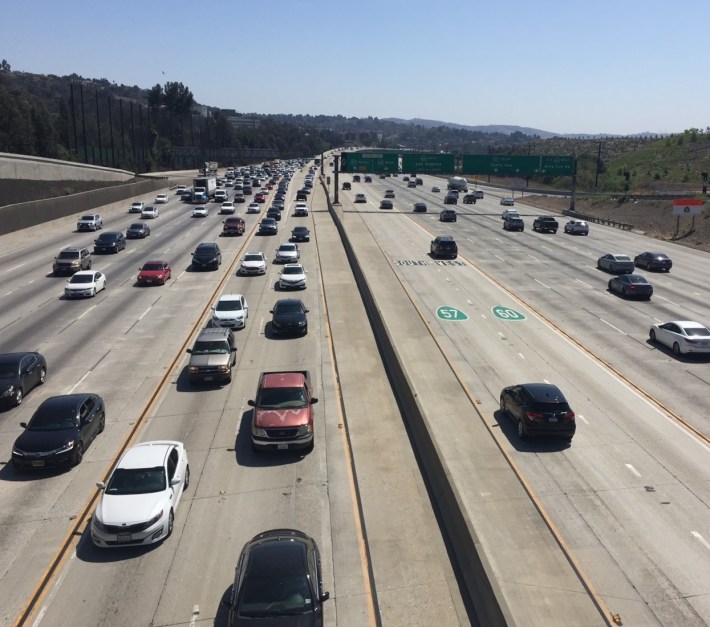
SR-57/SR-60 Interchange Improvements
Project cost: $500+ million
FY23 proposed: $129.93 million
Widening: from 16 lanes to 20 lanes
Metro is in the middle of a multi-stage project to widen the trunk where the 57 and 60 Freeways merge in Diamond Bar. The early widening of the westbound side is done, having added one new general purpose auxiliary lane. The next construction phase would add an a new eastbound general purpose lane, and new parallel two-lane bypass ramps. The current FY23 budget proposal is trying to fund construction starting this year, which would accelerate the project ahead of the voter-approved 2025 groundbreaking.
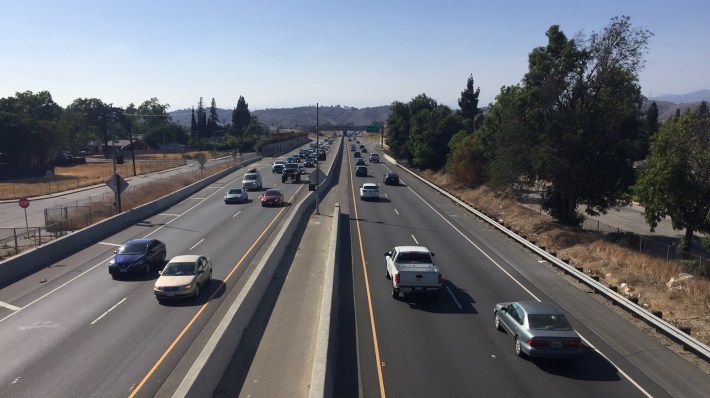
SR-71 Gap from I-10 to Rio Rancho Road
Project cost: south (under construction) $179 million, north (planned) ~$118+ million
FY23 proposed: $20 million
Widening: from 4 lanes to 8 lanes
Metro and Caltrans broke ground in 2021 on their project to widen the 71 Freeway from four lanes to eight. Preparations for the widening already evicted 24 families from their Pomona homes. Metro and Caltrans are also planning for a subsequent phase that would similarly widen the 71 north of Mission Boulevard.
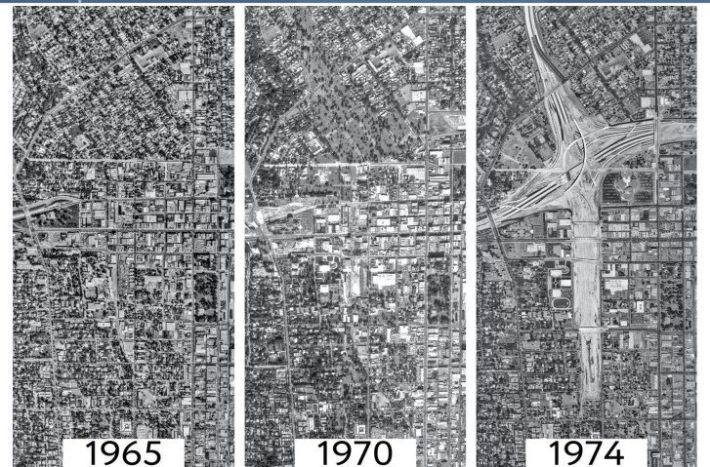
SR-710 N Corridor Mobility Improvements
Project cost: ~$780 million
FY23 proposed: $17.24 million
Widening: includes widening various streets
When Metro canceled the proposed $6+ billion North 710 Freeway tunnels project, the agency decided to distribute the project funding (~$780 million) to cities for multimodal transportation projects. Metro Highway Program staff twice rejected transit/bike/walk projects, instead steering North 710 funds to various street widening projects. Several N. 710 corridor cities - including Pasadena, Monterey Park, and San Marino - have had difficulty implementing unpopular, unneeded car-centric projects. Under Board Chair Hilda Solis's initiative this year, the Metro board re-re-affirmed that North 710 projects should be multimodal, and that cities were invited to revise and replace car-centric projects that Metro formerly pushed.
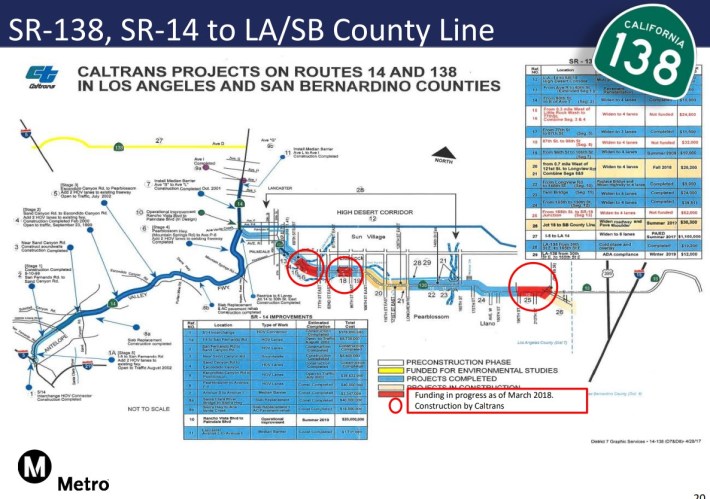
State Route 138 Capacity Enhancements (North County)
Project cost: total unknown ($200 million allocation in Measure R)
FY23 proposed: $10.7 million
Widening: from 2-4 lanes to 4-6 lanes
Metro and Caltrans have various plans to widen segments of Highway 138 through North L.A. County - funded in Measure R. There is also a push to shift High Desert "multi-purpose corridor" funding into mono-modal widening of the 138 (since the freeway portion of that project was canceled.) There is no Metro project page for its SR-138 widening project.
The Rest of the Highway Program Budget
All of the above twelve projects are widening - nearly all freeway widening, plus some widening of streets/ramps/intersections/etc.
Those twelve projects' FY23 allocations comprise the lion's share of the highway budget. They total $492 million, which is 77.6 percent of the $634 million total. If the entire Highway Program budget were just these twelve projects, the program total would exceed last year's overall FY22 highway expansion budget. [See SBLA budget spreadsheet]
Alongside those specific projects are miscellaneous highway costs (highway efficiency, highway operational improvements, highway planning and administration, and soundwalls) that total another $57 million (9 percent). These miscellaneous items are not tied clearly to specific widening projects, but if Metro is widening a bunch of highways and planning a bunch more highways, then it's probably a safe assumption that most of that planning is for projects that would widen highways.
After that 86 percent of the proposed FY23 Highway Program budget, what else is there? There's the roughly ten percent of the highway budget that goes to positive projects - ones that benefit carpooling and transit.
(Note that there are no projects in the Highway Program budget that significantly benefit pedestrians or cyclists. The caveat here is that, when Metro widens a bridge from two car lanes to ten car lanes, they sometimes include sidewalks and an occasional bike lane - generally what had already been there. None of these are places where it's great to walk or bike, as can be seen in the photo above of the rebuilt Carmenita Bridge. It’s difficult to calculate the percentage of the highway budget allocated to these awful bike/walk facilities, but it is negligible - well below one percent.)
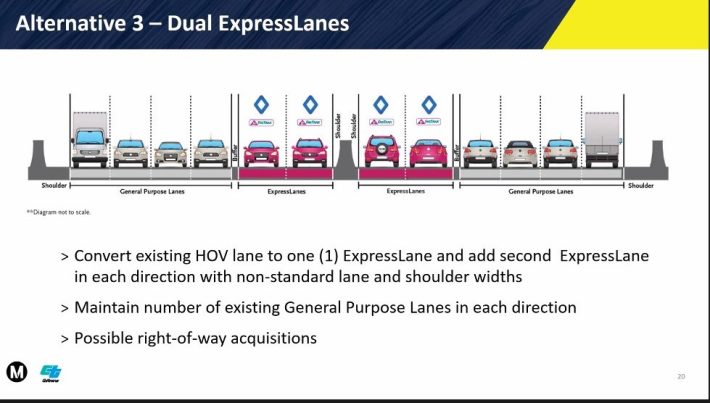
The FY23 proposed highway budget includes three ExpressLanes/Carpool Lane projects, totaling $46 million (7.3 percent). These projects arguably discourage single-occupancy vehicles (at least, they discourage SOVs that don't pay tolls), but they do potentially include some freeway widening.
And then there are four projects (totaling $38 million - 6.0 percent) that benefit bus and train riders:
- Alameda Corridor East Grade Separations - $20 million (to facilitate safer, faster, more reliable rail/car/truck travel)
- High Desert Multi-Purpose Corridor - $250,000 (to include high-speed rail, bikeway, solar, rain capture)
- 210 Freeway Barrier Replacement $6.6 million (to prevent trucks from continuing to crash into the Metro L Line)
- NextGen Bus Lanes - $11.1 million (to speed up bus travel)
Metro staff will sometimes point to these projects - which are just six percent of the proposed FY23 Highway Program budget - and say that highway expansion is actually multimodal... but it's just not true.
Metro is spending hundreds of millions each year to widen highways, like there's no tomorrow. And, given the climate crisis, there won't be a tomorrow if Metro doesn't at least start to rein in these excesses.
Streets For All has launched a campaign for the interested public to weigh in on Metro's proposed freeway widening budget increase. Use the SFA alert page to let Metro leadership know what you think.
